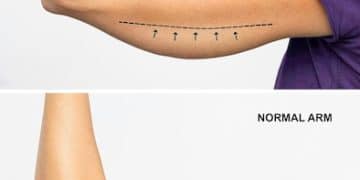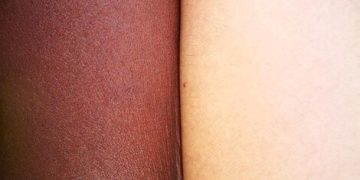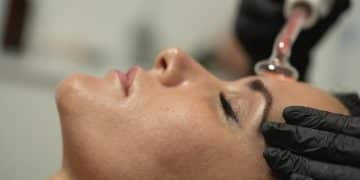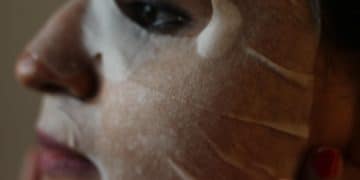Microneedling Breakthrough: 40% Acne Scar Reduction in 6 Months?
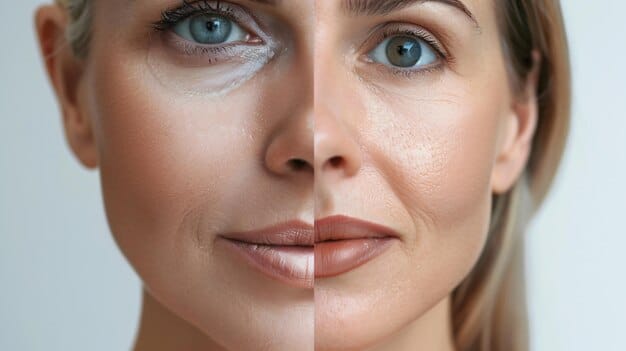
New research indicates that microneedling can significantly reduce acne scarring, with studies showing up to a 40% improvement in just six months, offering a promising solution for individuals seeking clearer skin.
Is smoother, clearer skin finally within reach? New research: Can microneedling reduce acne scarring by 40% in just 6 months? finds that this minimally invasive procedure offers a significant breakthrough in the treatment of acne scars, giving hope to those struggling with persistent skin imperfections.
Understanding Acne Scarring and Microneedling
Acne scarring can be a frustrating and persistent issue for many, long after the acne itself has cleared. But what causes these scars, and how does microneedling offer a potential solution?
Acne scars form when the skin’s natural healing process after a breakout is disrupted. This can lead to an overproduction of collagen, resulting in raised scars (hypertrophic scars), or a loss of tissue, creating depressed scars (atrophic scars). Traditional treatments often come with limitations, driving the search for more effective options.
The Science Behind Microneedling
Microneedling, also known as collagen induction therapy, involves using a device with tiny needles to create controlled micro-injuries in the skin. These tiny punctures stimulate the body’s natural wound-healing response, triggering collagen and elastin production.
Types of Acne Scars Addressed
Microneedling is particularly effective for treating atrophic acne scars, such as ice pick scars, boxcar scars, and rolling scars. The increased collagen production helps to fill in these depressions, resulting in a smoother skin surface.
- Ice pick scars: Deep, narrow scars that resemble puncture marks.
- Boxcar scars: Broad, box-like depressions with sharply defined edges.
- Rolling scars: Wide, shallow depressions with sloping edges that create a rolling appearance on the skin.
The appeal of microneedling lies in its ability to stimulate the skin’s natural healing processes, leading to long-term improvements in scar appearance. It’s a minimally invasive procedure with relatively short recovery times, making it an attractive option for many.
Microneedling offers a promising approach to addressing acne scarring by harnessing the body’s own healing mechanisms. By understanding the science behind the procedure, individuals can make informed decisions about whether it’s the right treatment option for their skin.
The Recent Study: Key Findings
A groundbreaking study has brought new hope to individuals struggling with acne scars. What exactly did this research uncover about microneedling’s effectiveness?
This recent study, published in a reputable dermatology journal, investigated the efficacy of microneedling in reducing acne scarring. The researchers followed a group of participants with moderate to severe acne scars over a six-month period.
Study Design and Methodology
The study employed a randomized, controlled trial design. Participants were divided into two groups: one group received microneedling treatments, while the control group received a sham treatment. The microneedling group underwent a series of sessions spaced several weeks apart.
Quantifiable Results: The 40% Reduction
The study’s most significant finding was that participants in the microneedling group experienced an average of 40% reduction in acne scar severity after six months. This was assessed using standardized scar rating scales and before-and-after photographs.
Additional Benefits Observed
Beyond the reduction in scar severity, participants also reported improvements in skin texture, tone, and overall appearance. These additional benefits contribute to the positive impact of microneedling on overall skin health.

- Significant reduction in acne scar severity
- Improved skin texture and tone
- Enhanced overall skin appearance
The findings of this study provide compelling evidence for the effectiveness of microneedling in reducing acne scarring. The 40% reduction in scar severity, coupled with the observed improvements in skin texture and tone, highlight the potential of this treatment for individuals seeking clearer, smoother skin.
How Microneedling Works: A Detailed Look
To fully appreciate the potential of microneedling, it’s essential to understand the intricate processes it triggers within the skin. Let’s delve deeper into the mechanisms of action.
Microneedling works by creating controlled micro-injuries in the skin, which then stimulate the body’s natural healing response. This process involves several key steps that contribute to scar reduction and skin rejuvenation.
The Initial Injury Response
The tiny needles used in microneedling create microscopic punctures in the skin, triggering an immediate inflammatory response. This response attracts immune cells, such as neutrophils and macrophages, to the treatment area.
Collagen and Elastin Production
The micro-injuries stimulate fibroblasts, the cells responsible for producing collagen and elastin. Collagen provides structural support to the skin, while elastin gives it elasticity and resilience. The increased production of these proteins helps to fill in depressed scars and improve skin texture.
Remodeling of Scar Tissue
Microneedling also promotes the remodeling of existing scar tissue. The controlled injuries break down the disorganized collagen fibers that make up scars, allowing for the formation of new, healthier collagen.
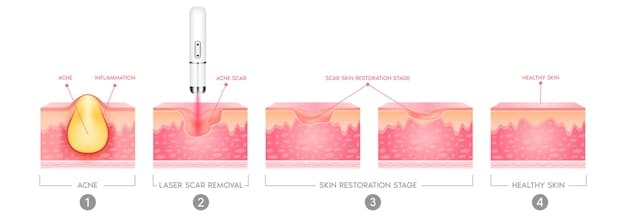
- Stimulates the body’s natural healing response
- Increases collagen and elastin production
- Promotes remodeling of scar tissue
Microneedling’s ability to trigger the body’s own healing mechanisms makes it a unique and effective treatment for acne scarring. By understanding the intricate processes involved, individuals can have a clearer picture of how this procedure can lead to significant improvements in their skin.
Comparing Microneedling to Other Acne Scar Treatments
While microneedling shows promise, it’s essential to consider how it stacks up against other available acne scar treatments. What are the relative advantages and disadvantages?
A variety of treatments are available for acne scars, each with its own set of characteristics. These include topical treatments, chemical peels, laser therapy, and surgical options. Microneedling offers a unique balance of effectiveness, invasiveness, and cost.
Topical Treatments: A Limited Impact
Topical treatments, such as retinoids and alpha hydroxy acids (AHAs), can improve skin texture and reduce the appearance of mild scars. However, they typically have limited impact on more severe acne scars.
Chemical Peels: Varying Depths of Exfoliation
Chemical peels involve applying a chemical solution to the skin, causing it to exfoliate and peel off. Deeper peels can be effective for treating acne scars, but they also carry a higher risk of side effects, such as scarring and pigmentation changes.
Laser Therapy: Precision and Power
Laser therapy uses focused light energy to remove or remodel scar tissue. Different types of lasers are available, each with its own strengths and weaknesses. Laser treatments can be effective but can also be costly and require multiple sessions.
Surgical Options: More Invasive Solutions
Surgical options, such as punch excision and subcision, are more invasive treatments used for severe acne scars. These procedures can provide significant improvements, but they also involve a higher risk of complications and longer recovery times.
Microneedling stands out as a minimally invasive treatment option with a relatively short recovery time. While it may not be as powerful as laser therapy or surgery for very severe scars, it offers a good balance of effectiveness and safety for many individuals.
Who is a Good Candidate for Microneedling?
Microneedling can be a beneficial treatment for many, but not everyone is an ideal candidate. Understanding the criteria for candidacy can help individuals make informed decisions.
The best candidates for microneedling are individuals with mild to moderate acne scarring who are looking for a minimally invasive treatment option. Several factors can influence candidacy.
Skin Type and Tone
Microneedling is generally safe for all skin types and tones. However, individuals with darker skin tones may be at a slightly higher risk of post-inflammatory hyperpigmentation (PIH), a temporary darkening of the skin.
Severity of Scarring
Microneedling is most effective for treating atrophic acne scars, such as ice pick scars, boxcar scars, and rolling scars. It may not be as effective for hypertrophic scars or keloids, which are raised scars.
Overall Health
Individuals with certain medical conditions, such as active skin infections, bleeding disorders, or a history of keloid scarring, may not be good candidates for microneedling.
- Mild to moderate acne scarring
- All skin types and tones (with caution for darker skin)
- Good overall health
A consultation with a qualified dermatologist or skincare professional is essential to determine whether microneedling is the right treatment option for a specific individual. They can assess the severity of scarring, evaluate skin type and tone, and review medical history to determine if microneedling is appropriate.
What to Expect During and After Microneedling
Knowing what to expect during and after a microneedling session can help individuals feel more prepared and comfortable with the treatment process. Let’s walk through the typical experience.
A typical microneedling session involves several steps, from preparation to aftercare. Understanding the process can ease any anxiety and help individuals achieve the best possible results.
During the Procedure
Before the procedure, the skin is cleansed, and a topical numbing cream is applied to minimize discomfort. The microneedling device is then passed over the skin, creating tiny punctures. The session typically lasts 30-60 minutes, depending on the size of the treatment area.
Immediately Afterward
Immediately after the procedure, the skin may be red and slightly swollen, similar to a mild sunburn. Some individuals may experience pinpoint bleeding or bruising. These effects usually subside within a few days.
The Recovery Process
The recovery process after microneedling is relatively short. Most individuals can return to their normal activities within a day or two. It’s essential to follow the aftercare instructions provided by the skincare professional, which may include avoiding sun exposure, using gentle cleansers, and applying hydrating moisturizers.
- Redness and swelling immediately after the procedure
- Short recovery time (1-2 days)
- Importance of following aftercare instructions
By understanding what to expect during and after microneedling, individuals can approach the treatment with confidence. The short-term side effects are typically mild and manageable, and the long-term benefits can be significant.
Maintaining Results and Long-Term Skincare
Achieving desired results is just one part of the journey. What steps can be taken to maintain the improvements gained from microneedling and ensure long-term skin health?
To maintain the improvements achieved with microneedling, it’s essential to adopt a comprehensive skincare routine. This includes protecting the skin from sun damage, using appropriate skincare products, and considering maintenance treatments.
Sun Protection: A Non-Negotiable
Sun exposure can exacerbate acne scarring and reverse the benefits of microneedling. Using a broad-spectrum sunscreen with an SPF of 30 or higher is crucial for protecting the skin from harmful UV rays.
Skincare Products: Choose Wisely
Using gentle, non-comedogenic skincare products can help to maintain skin health and prevent future breakouts. Look for products that contain ingredients like hyaluronic acid, which can help to keep the skin hydrated and plump.
Maintenance Treatments: Periodic Boosts
Periodic maintenance treatments with microneedling can help to sustain the improvements achieved with the initial series of sessions. These treatments can be spaced several months apart and can help to stimulate continued collagen production.
| Key Point | Brief Description |
|---|---|
| ☀️ Sun Protection | Daily sunscreen use is essential to prevent scar aggravation. |
| 🧴 Gentle Skincare | Use non-comedogenic products to keep skin healthy and prevent breakouts. |
| 🗓️ Maintenance Treatments | Consider periodic microneedling sessions to sustain collagen production. |
| 💧 Hydration | Keep skin well-hydrated with moisturizers containing hyaluronic acid. |
Frequently Asked Questions (FAQ)
▼
The number of sessions varies depending on the severity of the scars. Typically, 3-6 sessions spaced several weeks apart are recommended. Visible improvements can often be seen after just a few treatments.
▼
A topical numbing cream is usually applied before the procedure to minimize discomfort. Most people report feeling only mild pressure or a slight prickling sensation during the treatment.
▼
Common side effects include redness, swelling, and pinpoint bleeding, which usually resolve within a few days. More rare side effects can include infection or post-inflammatory hyperpigmentation.
▼
Yes, microneedling can be combined with other treatments, such as topical serums, to enhance results. Your skincare professional can recommend the best combination for your specific needs.
▼
The results of microneedling can be long-lasting, especially when combined with a good skincare routine and periodic maintenance treatments. Collagen production continues for several months after each session.
Conclusion
The latest research confirms that microneedling is a promising treatment for reducing acne scarring, with studies showing a significant improvement. With its minimally invasive nature and short recovery time, it offers a hopeful solution for those seeking clearer, smoother skin and renewed confidence.
